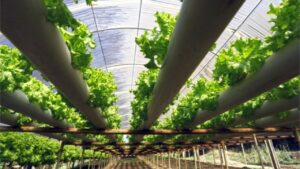Urban hydroponic gardens have become increasingly popular among city dwellers, especially those seeking a practical and sustainable way to grow their own food. Hydroponics is a cultivation method where plants are grown without soil, using a nutrient solution rich in essential minerals. This system allows for a wide variety of plants to be grown, even in small spaces like apartments or balconies, making it perfect for urban environments.
Starting a hydroponic garden at home offers many benefits. In addition to the joy of growing your own food, you ensure the freshness and quality of the vegetables and herbs you consume, free from pesticides. Hydroponics is also more efficient in terms of water and space usage, making it a more sustainable option in urban settings. Another advantage is that, since it doesn’t rely on soil, it’s possible to grow in areas with poor soil quality or even in locations without traditional gardens.
For beginners, choosing the right plants for your hydroponic garden is essential. Some plants are better suited for beginners due to their ease of cultivation and adaptability to the controlled environment of hydroponics. When selecting plants, it’s important to consider factors such as light requirements, the type of nutrients the plants need, and the harvest time. Choosing fast-growing varieties, like lettuce, herbs, and leafy greens, can be an excellent way to start your hydroponic gardening journey.
What is a Hydroponic Garden?
A hydroponic garden is a cultivation system where plants are grown without soil. Instead, the roots of the plants are suspended in a nutrient solution composed of water and essential minerals, providing all the nutrients necessary for healthy plant growth. This method allows plants to receive more precise control over nutrients and water, resulting in faster and more productive growth.
Hydroponics can be applied in various ways, including systems like nutrient film techniques, floating root systems, or substrate-based systems. All these methods share the common idea of replacing soil with a liquid solution or an inorganic medium that supports the plant roots, allowing them to grow efficiently and healthily.
Among the main advantages of hydroponics for urban life are efficient use of space and water. Since there is no need for large areas of soil, hydroponic gardens can be set up on balconies, rooftops, or even indoors, making the most of the limited spaces found in cities. Additionally, water consumption is significantly lower than in traditional farming, as the nutrient solution can be recycled and recirculated, reducing waste.
Another important benefit is the reduction in the use of pesticides and chemical fertilizers, as the controlled environment of hydroponics makes it easier to monitor and prevent pests. This makes growing food healthier and more sustainable, without the need for harmful chemicals. For these reasons, hydroponics offers a practical, eco-friendly, and accessible alternative for anyone looking to grow fresh, high-quality food amidst the fast-paced urban lifestyle.
Factors to Consider When Choosing Plants for Your Hydroponic Garden
When starting a hydroponic garden, choosing the right plants is essential for ensuring a successful crop. Several factors need to be taken into account to ensure plants grow healthy and productive in the controlled environment of hydroponics. Among these factors, light and temperature requirements, tolerance to humidity and pH of the nutrient solution, and ease of cultivation and harvest time are particularly important.
- Light and Temperature RequirementsEach plant has its own light and temperature needs for optimal growth. Light is essential for photosynthesis, and hydroponic plants generally need intense and consistent light to grow well. Some plants, like lettuce and herbs, prefer moderate or indirect light, while others, like tomatoes and peppers, may require more direct light. Additionally, the temperature of the environment and the nutrient solution should be monitored. Most hydroponic plants thrive best in temperatures between 18°C and 24°C. Higher or lower temperatures can harm growth and reduce productivity.
- Tolerance to Humidity and pH of the Nutrient SolutionHumidity and the pH of the nutrient solution are crucial for plant development. The nutrient solution should have a balanced pH, typically between 5.5 and 6.5, to ensure that plants can efficiently absorb nutrients. Some plants may be more sensitive to pH fluctuations, so it’s important to choose varieties that are tolerant to this parameter or that adapt well to precise pH control. In addition, the humidity of the environment can also affect plant growth. Some plants, like lettuce and arugula, grow better in more humid environments, while others, like basil, prefer drier conditions.
- Ease of Cultivation and Harvest TimeAnother important factor when choosing plants for your hydroponic garden is ease of cultivation. Some plants are naturally easier to grow in hydroponic systems, such as lettuce, herbs, and spinach. They have a quick growth cycle and require less maintenance compared to more demanding plants. Moreover, the harvest time should also be considered. Some plants, like lettuce, can be harvested in just a few weeks, while others, like tomatoes, may take months to mature. For beginners, opting for fast-growing, easy-to-cultivate plants can be a great choice, ensuring a quick and satisfying harvest.
By considering these factors, you can select the most suitable plants for your hydroponic system, ensuring a more efficient and rewarding gardening experience.
- See Also: Complete Guide to Setting Up Your Hydroponic Garden at Home
- Follow Us: https://www.facebook.com/profile.php?id=61565415975218
The Best Plants to Start Your Hydroponic Garden
Starting a hydroponic garden is an excellent way to grow fresh food in urban spaces. Some plants are particularly well-suited for beginners because they grow quickly and adapt well to hydroponic systems. Here are some of the best options to get started with your hydroponic garden:
Lettuce
- Advantages of growing hydroponic lettuceLettuce is one of the most popular plants in hydroponic cultivation due to its rapid growth and ease of care. It grows well in hydroponic systems such as nutrient film techniques or deep water culture, making it ideal for beginners. Lettuce requires minimal maintenance and can be harvested in about 30 to 45 days, depending on the variety.
- Care and harvest tipsLettuce needs plenty of light, but preferably indirect light to avoid leaf burn. Keep the temperature between 18°C and 22°C and regulate the pH of the nutrient solution to around 6.0. You can harvest by cutting the outer leaves, allowing the inner ones to continue growing.
Spinach
- How spinach adapts to hydroponicsSpinach is an excellent choice for hydroponics, especially because it thrives in cooler and more humid conditions. It adapts well to hydroponic systems like substrate-based or continuous flow systems and can grow efficiently in controlled environments. Spinach is ideal for cooler climates but can also be successfully grown in hydroponic systems with temperature control.
- Nutritional benefits and cultivation tipsSpinach is rich in vitamins A, C, and K, as well as minerals like iron and calcium. It prefers a pH between 6.0 and 7.0 and cooler temperatures, around 16°C to 21°C. Be sure to keep the nutrient solution rich in nitrates, as spinach responds well to these nutrients, resulting in more nutritious and flavorful leaves.
Herbs like Basil and Cilantro
- Reasons to choose herbs for hydroponicsHerbs like basil, cilantro, mint, and oregano are excellent choices for hydroponic gardening. They have a quick growth cycle, require little space, and are relatively easy to care for, making them perfect for hydroponic systems. Herbs can be grown in small containers, which makes them ideal for those with limited space.
- Care and easy cultivation tipsThese herbs need plenty of light (either direct or indirect) and moderate temperatures, generally between 18°C and 24°C. Basil and cilantro prefer a pH of 6.0 to 7.0. Keep the nutrient solution balanced, with a focus on nitrogen to encourage leaf growth. For continuous harvest, remove the older leaves and encourage new shoots to grow.
Green Onions and Leeks
- How these plants thrive in hydroponic systemsGreen onions and leeks are easy to grow in hydroponic systems. They adapt well to substrate-based systems and grow vertically, making them perfect for compact gardens. Both plants grow quickly, providing frequent harvests, and can be cultivated year-round in indoor environments.
- Tips for healthy growthThese plants prefer temperatures between 18°C and 22°C and a pH of 6.0 to 7.0. For optimal growth, ensure the nutrient solution has adequate levels of potassium and calcium. Green onions can be harvested by cutting the outer leaves, while leeks require more time to reach their full size but can be harvested in stages.
Arugula and Watercress
- Characteristics of fast-growing leafy greensArugula and watercress are fast-growing leafy greens that are easy to cultivate in hydroponic systems. They are perfect for those seeking a quick harvest and a peppery flavor. Both plants require little space and can be grown in small systems, making them ideal for apartments and balconies.
- How to achieve a good harvest in small spacesThese plants thrive in hydroponic systems with good nutrient circulation and constant light. The ideal temperature for arugula and watercress is between 18°C and 22°C, with a pH between 6.0 and 7.0. They grow quickly and can be harvested in 3 to 4 weeks after planting. For abundant harvests, remove the outer leaves as they grow, allowing the younger leaves to continue developing.
These plants are some of the best options for starting a hydroponic garden. They are easy to grow, adapt well to soil-free cultivation, and provide a quick and nutritious harvest. Start with these varieties, and soon you’ll be able to expand your garden with more hydroponic plants!
Essential Care for Growing Your Hydroponic Plants
Growing a hydroponic garden requires specific care to ensure your plants develop properly and provide a healthy harvest. Although soil-free cultivation offers many advantages, maintaining the system and controlling essential growth factors is crucial. Here are some essential care tips for the success of your hydroponic garden:
Maintaining the Nutrient Solution
The nutrient solution is the heart of a hydroponic system, as it provides the necessary nutrients for plant growth. Therefore, it’s essential to keep the solution clean and balanced. Change the solution every 2-3 weeks to avoid the buildup of residues and ensure that nutrients stay fresh. Pay attention to water levels, especially in recirculating systems, as evaporation can reduce the amount of solution.
Additionally, it’s important to make sure the solution has the right concentration of nutrients, particularly nitrogen, phosphorus, potassium, and calcium, which are essential for healthy plant growth. In larger-scale systems, using an electrical conductivity (EC) meter to check the nutrient concentration in the solution can be helpful.
Controlling pH and Nutrients
Controlling the pH and nutrient concentration is crucial for healthy plant development in hydroponics. The pH of the nutrient solution should be kept within an ideal range for each type of plant, generally between 5.5 and 6.5. If the pH is outside this range, plants may struggle to absorb nutrients properly, which can hinder their growth and health.
It is recommended to test the pH regularly using a pH meter. If the value is outside the ideal range, you can adjust it with specific solutions to raise or lower the pH. Also, regularly check the nutrient levels in the solution to ensure the plants are receiving the necessary nutrients at each stage of their growth.
How to Prevent Common Pests and Diseases
Although hydroponic gardens are less prone to pest infestations than traditional gardens, some problems can still arise. Pests such as aphids, scale insects, and mites may infiltrate the environment. To prevent these issues, keep your system clean and inspect your plants regularly.
A good practice is to use biological control methods, such as introducing beneficial insects that help naturally control pests. If necessary, you can resort to organic pesticides, but always with caution, to avoid harming the hydroponic system.
In addition to pests, diseases like fungi and bacteria can develop, especially in high-humidity environments. To prevent this, avoid stagnant water around the roots and plant surfaces. Keep the area around the garden well-ventilated and clean the system components regularly to avoid contamination. If you notice signs of disease, such as yellowing leaves or spots, remove the affected parts immediately to prevent spreading.
With these care tips, your hydroponic garden will thrive and be productive. The success of the cultivation depends on constant attention to details, such as maintaining the nutrient solution, controlling pH, and preventing pests and diseases. By following these practices, you’ll be able to enjoy abundant, high-quality harvests year-round.
Conclusion
For beginners, choosing the right plants is key to ensuring a successful start. The best options to begin with include lettuce, spinach, herbs like basil and cilantro, as well as vegetables like green onions, leeks, arugula, and watercress. These plants are easy to grow, grow quickly, and adapt well to hydroponic systems, providing abundant harvests in a short amount of time.
If you’re thinking about starting your own urban hydroponic garden, don’t hesitate to take the first step! With a little attention and dedication, you can enjoy fresh, nutritious, pesticide-free food directly from your own space. No matter the size of your environment, hydroponics offers an efficient solution for growing plants in small urban spaces.
To ensure a successful harvest, remember to regularly monitor the nutrient solution, control the pH, and make sure your plants receive adequate light. Additionally, keep the environment clean and inspect your plants for pests and diseases. By following these simple tips, you’ll be on the right track to having a healthy and productive hydroponic garden.
Now, it’s time to get your hands dirty and start growing your own hydroponic plants!




